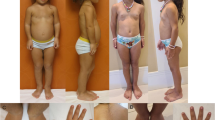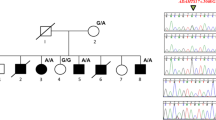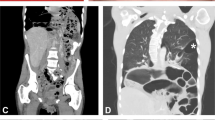Abstract
Crouzon syndrome, an autosomal dominant condition characterized by craniosynostosis, ocular proptosis and midface hypoplasia, is associated with mutations in fibroblast growth factor receptor 2 (FGFR2) (refs 1–3). For example, we have identified 10 different mutations in the FGFR2 extracellular immunoglobulin III (Iglll) domain in 50% (16/32) of our Crouzon syndrome patients2,4,5. All mutations described so far for other craniosynos-totic syndromes with associated limb anomalies — Jackson–Weiss2,4, Pfeiffer6–9, and Apert10,11 — also occur in the extracellular domain of FGFR2, as well as FGFR1 for Pfeiffer syndrome. In contrast, only FGFR3 mutations have been reported in dwarfing conditions — achondroplasia12–14, thanatophoric dyspla-sia15,16, and hypochondroplasia17. For achondroplasia, greater than 99% of mutations occur in the FGFR3 transmembrane domain12–14,18,19. We now report the unexpected observation of a FGFR3 transmembrane domain mutation, Ala391Glu, in three unrelated families with Crouzon syndrome and acanthosis nigricans, a specific skin disorder of hyperkeratosis and hyperpigmentation. The association of non–dwarfing and even non–skeletal conditions with FGFR3 mutations reveals the potential for a wide range of FGFR pleiotropic effects as well as locus heterogeneity in Crouzon syndrome. Our study underscores the biologic complexity of the FGFR gene family.
This is a preview of subscription content, access via your institution
Access options
Subscribe to this journal
Receive 12 print issues and online access
$209.00 per year
only $17.42 per issue
Buy this article
- Purchase on Springer Link
- Instant access to full article PDF
Prices may be subject to local taxes which are calculated during checkout
Similar content being viewed by others
References
Reardon, W. et al. Mutations in the fibnoblast growth factor receptor 2 gene cause Crouzon syndrome. Nature Genet. 8, 98–103 (1994).
Jabs, E.W. et al. Jackson–Weiss and Crouzon syndromes are allelic with mutations in fibroblast growth factor receptor 2. Nature Genet. 8, 275–279 (1994).
Gorry, M.C. et al. Crouzon syndrome: mutations in two spliceoforms of FGFR2 and a common point mutation shared with Jackson–Weiss syndrome. Hum. molec. Genet. 4, 1387–1390 (1995).
Park, W.-J. et al. Novel FGFR2 mutations in Crouzon and Jackson–Weiss syndromes show allelic heterogeneity and phenotypic variability. Hum. molec. Genet. 4, 1229–1233 (1995).
Li, X., Park, W.-J., Pyeritz, R.E. & Jabs, E.W. Effect on splicing of a silent FGFR2 mutation in Crouzon syndrome. Nature Genet. 9, 232–233 (1995).
Muenke, M. et al. A common mutation in the fibroblast growth factor receptor 1 gene in Pfeiffer syndrome. Nature Genet. 8, 269–274 (1994).
Rutland, P. et al. Identical mutations in the FGFR2 gene cause both Pfeiffer and Crouzon syndrome phenotypes. Nature Genet. 9, 173–176 (1995).
Lajeunie, E., Ma, H.W., Bonaventure, J., Munnich, A. & Merrer, M.L. FGFR2 mutations in Pfeiffer syndrome. Nature Genet. 9, 108 (1995).
Schell, U. et al. Mutations in FGFR1 and FGFR2 cause both familial and sporadic Pfeiffer syndrome. Hum. molec. Genet. 4, 323–328 (1995).
Wilkie, A.O.M. et al. Apert syndrome results from localized mutations of FGFR2 and is allelic with Crouzon syndrome. Nature Genet. 9, 165–172 (1995).
Park, W.-J. et al. Analysis of phenotypic features and FGFR2 mutations in Apert syndrome. Am. J. hum. Genet. 57, 321–328 (1995).
Shiang, R. et al. Mutations in the transmembrane domain of FGFRS cause the most common genetic form of dwarfism, achondroplasia. Cell 78, 335–342 (1994).
Rousseau, F. et al. Mutations in the gene encoding fibroblast growth factor receptor-3 in achondroplasia. Nature 371, 252–254 (1994).
Supertifurga, A. et al. A glycine–375–to–cysteine substitution in the transmembrane domain of the fibroblast growth factor receptor–3 in a newborn with achondroplasia. Eur. J. Ped. 154, 215–219 (1995).
Tavormina, P.L. et al. Thanatophoric dysplasia (types I and II) caused by distinct mutations in fibroblast growth factor receptor 3. Nature Genet. 9, 321–328 (1995).
Rousseau, F. et al. Stop codon FGFR3 mutations in thanatophoric dwarfism type 1. Nature Genet. 10, 11–12 (1995).
Bellus, G.A. et al. A recurrent mutation in the tyrosine kinase domain of fibroblast growth factor receptor 3 causes hypochondroplasia. Nature Genet. 10, 357–359 (1995).
Bellus, G.A. et al. Achondroplasia is defined by recurrent G380R mutations of FGFRS. Am. J. hum. Genet. 56, 368–373 (1995).
Stoilov, I., Kilpatrick, M.W. & Tsipouras, P. A common FGFRS gene mutation is present in achondroplasia but not in hypochondroplasia. Am. J. med. Genet. 55, 127–133 (1995).
Rendon, M.I., Cruz, P.D. Jr, Sontneimer, R.D. & Bergstresser, P.R. Acanthosis nigricans: a cutaneous marker of tissue resistance to insulin. J. Am. Acad. Derm. 21, 461–469 (1989).
Orlow, S.J. Cutaneous findings in craniofacial malformation syndromes. Arch. Dermatol. 128, 1379–1386 (1992).
Breitbart, A.S., Eaton, C. & McCarthy, J.G. Crouzon's syndrome associated with acanthosis nigricans: ramifications for the craniofacial surgeon. Ann. Plastic Surg. 22, 310–315 (1989).
Shi, D.L., Fromentoux, V, Launay, C., Umbhauer, M. & Boucaut, J.C. Isolation and developmental expression of the amphibian homolog of the fibroblast growth factor receptor 3. J. Cell Sci. 107, 417–425 (1994).
Noji, S. et al. Differential expression of three chick FGF receptor genes, FGFR1, FGFR2, and FGFRS, in limb and feather development. Prog. clin. biol. Res. 638, 645–654 (1993).
Peters, K., Ornitz, D., Wemer, S. & Williams, L. Unique expression pattern of the FGF receptor 3 gene during mouse organogenesis. Dev. Biol. 155, 423–430 (1993).
Murgue, B., Tsunekawa, S., Rosenberg, I., deBeaumont, M. & Podolsky, O.K. Identification of a novel variant form of fibroblast growth factor receptor 3 (FGFRS Illb) in human colonic epithelium. Cancer Res. 54, 5206–5211 (1994).
Partanen, J. et al. FGFR-4, a novel acidic fibroblast growth factor receptor with a distinct expression pattern. EMBO 10, 1347–1354 (1991).
Chellaiah, A.T., McEwen, D.G., Werner, S., Xu, J. & Ornitz, D.M. Fibroblast growth factor receptor (FGFR) 3. J. biol. Chem. 269, 11620–11627 (1994).
Avivi, A., Yayon, A. & Givol, D. A novel form of FGF receptor–3 using an alternative exon in the immunoglobulin domain III. FEBS Lett. 330, 249–252 (1993).
Ullrich, A. & Schlessinger, J. Signal transduction by receptors with tyrosine kinase activity. Cell 61, 203–212 (1990).
Author information
Authors and Affiliations
Rights and permissions
About this article
Cite this article
Meyers, G., Orlow, S., Munro, I. et al. Fibroblast growth factor receptor 3 (FGFR3) transmembrane mutation in Crouzon syndrome with acanthosis nigricans. Nat Genet 11, 462–464 (1995). https://doi.org/10.1038/ng1295-462
Received:
Accepted:
Issue Date:
DOI: https://doi.org/10.1038/ng1295-462
This article is cited by
-
Craniofacial growth and function in achondroplasia: a multimodal 3D study on 15 patients
Orphanet Journal of Rare Diseases (2023)
-
Autosomal dominant familial acanthosis nigricans caused by a C-terminal nonsense mutation of FGFR3
Journal of Human Genetics (2021)
-
Adapting SureSelect enrichment protocol to the Ion Torrent S5 platform in molecular diagnostics of craniosynostosis
Scientific Reports (2020)
-
Achondroplasia: a comprehensive clinical review
Orphanet Journal of Rare Diseases (2019)
-
Knock-in human FGFR3 achondroplasia mutation as a mouse model for human skeletal dysplasia
Scientific Reports (2017)



